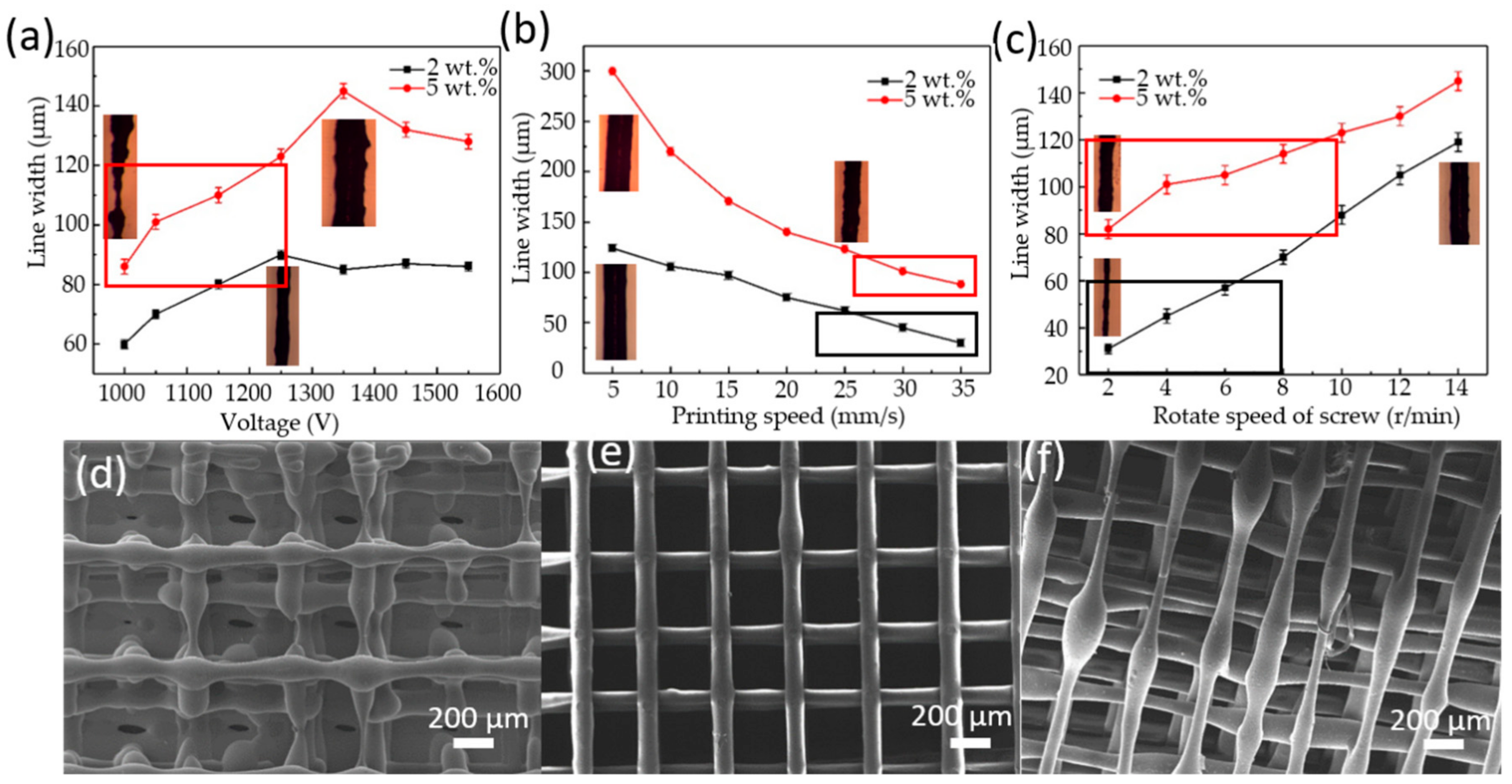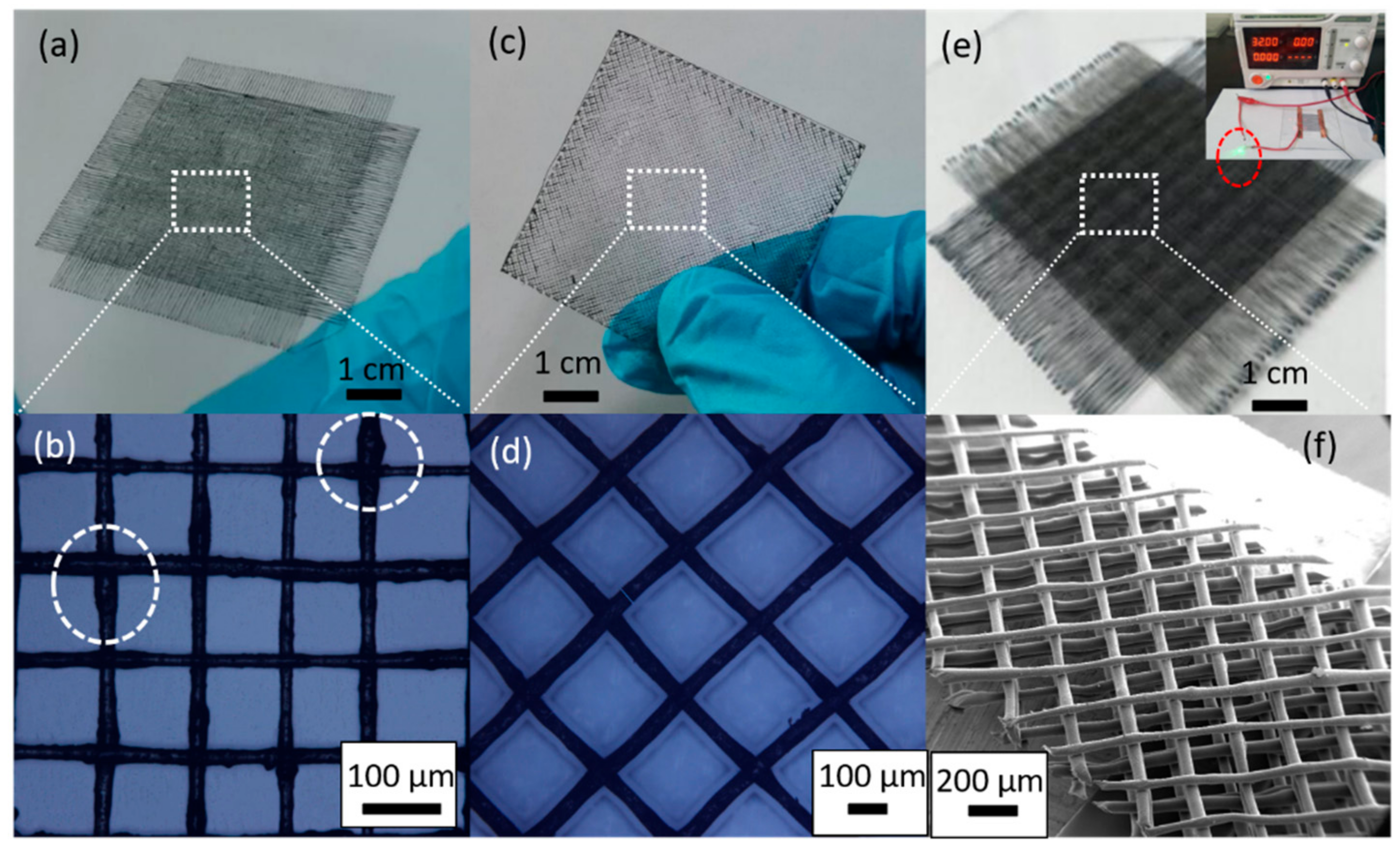The Electric-Field-Driven Fusion Jetting 3D Printing for Fabricating High Resolution Polylactic Acid/Multi-Walled Carbon Nanotube Composite Micro-Scale Structures
Abstract
:1. Introduction
2. Materials and Methods
2.1. Experimental Platform and Working Principals
2.2. Raw Materials for 3D Printing
2.3. Evaluation of Microstructure and Performance
3. Results
3.1. The Optimization of Process Parameters
3.2. The Fabrication and Evaluation of PLA/MWCNT Composites
4. Discussion
- (1)
- The influences of processing parameters (the carbon loading, voltage, screw speed, and printing speed) on the line width and printing quality of printed parts were studied. The line width increases with the increase of carbon loading and screw speed, firstly increases to a peak and then keeps stable with the increase of voltage, and decreases with the increase of printing speed. Considering both the small line width (20–60 μm for 2 wt.% and 80–120 μm for 5 wt.%) and good printing quality, the parameters have been optimized as the screw speed (4–6 rpm), the voltage of 1050 v, and the printing speed (30–35 mm/s).
- (2)
- Two single-layer meshes with line width of 30 µm and 60 µm, a six-layer conductive biomimetic scaffold with 5 wt.% MWCNT and the line width of 100 μm for the application of conductive biomimetic scaffold, and the anisotropic flexible conductive meshes have been prepared successfully for demonstrating its printing capability.
- (3)
- For the composites with loading range of MWCNT from 2 wt.% to 5 wt.%, the AC conductivity increases, and dielectric loss (tanδ) decreases with the increasing of frequency. The highest AC conductivity values obtained here of 2 wt.% and 5 wt.% for the highest frequency of 106 Hz are 10−8 and 10−6 S/cm, respectively, and the SEM images shows the uniformly distributed MWCNT in the PLA matrix of composites with both 2 wt.% and 5 wt.% MWCNT.
Author Contributions
Funding
Conflicts of Interest
References
- Ali, A.; Ali, F.; Irfan, M.; Muhammad, F.; Glowacz, A.; Antonino-Daviu, J.A.; Caesarendra, W.; Qamar, S. Mechanical Pressure Characterization of CNT-Graphene Composite Material. Micromachines 2020, 11, 1000. [Google Scholar] [CrossRef]
- Luo, J.; Wang, H.; Zuo, D.; Ji, A.; Liu, Y. Research on the Application of MWCNTs/PLA Composite Material in the Manufacturing of Conductive Composite Products in 3D Printing. Micromachines 2018, 9, 635. [Google Scholar] [CrossRef] [PubMed] [Green Version]
- Zhang, W.-D.; Phang, I.Y.; Liu, T. Growth of Carbon Nanotubes on Clay: Unique Nanostructured Filler for High-Performance Polymer Nanocomposites. Adv. Mater. 2006, 18, 73–77. [Google Scholar] [CrossRef]
- Yang, L.; Li, S.; Zhou, X.; Liu, J.; Li, Y.; Yang, M.; Yuan, Q.; Zhang, W. Effects of carbon nanotube on the thermal, mechanical, and electrical properties of PLA/CNT printed parts in the FDM process. Synth. Met. 2019, 253, 122–130. [Google Scholar] [CrossRef]
- Bautista-Quijano, J.R.; Pötschke, P.; Brünig, H.; Heinrich, G. Strain sensing, electrical and mechanical properties of polycarbonate/multiwall carbon nanotube monofilament fibers fabricated by melt spinning. Polymer 2016, 82, 181–189. [Google Scholar] [CrossRef]
- Zhou, B.; Li, Y.; Zhang, D.; Zheng, G.; Dai, K.; Mi, L.; Liu, C.; Shen, C. Interfacial adhesion enhanced flexible polycarbonate/carbon nanotubes transparent conductive film for vapor sensing. Compos. Commun. 2019, 15, 80–86. [Google Scholar] [CrossRef]
- Wang, X.; Jiang, M.; Zhou, Z.; Gou, J.; Hui, D. 3D printing of polymer matrix composites: A review and prospective. Compos. Part B Eng. 2017, 110, 442–458. [Google Scholar] [CrossRef]
- Ngo, T.D.; Kashani, A.; Imbalzano, G.; Nguyen, K.T.; Hui, D. Additive manufacturing (3D printing): A review of materials, methods, applications and challenges. Compos. Part B Eng. 2018, 143, 172–196. [Google Scholar] [CrossRef]
- Cao, Q.; Kim, H.-S.; Pimparkar, N.; Kulkarni, J.P.; Wang, C.; Shim, M.; Roy, K.; Alam, M.A.; Rogers, J.A. Medium-scale carbon nanotube thin-film integrated circuits on flexible plastic substrates. Nat. Cell Biol. 2008, 454, 495–500. [Google Scholar] [CrossRef]
- Duc, B.N.; Son, Y. Enhanced dispersion of multi walled carbon nanotubes by an extensional batch mixer in polymer/MWCNT nanocomposites. Compos. Commun. 2020, 21, 100420. [Google Scholar] [CrossRef]
- Gnanasekaran, K.K.; Heijmans, T.; Van Bennekom, S.; Woldhuis, H.; Wijnia, S.; De With, G.B.; Friedrich, H.H. 3D printing of CNT- and graphene-based conductive polymer nanocomposites by fused deposition modeling. Appl. Mater. Today 2017, 9, 21–28. [Google Scholar] [CrossRef]
- Zhang, X.; Fan, W.; Liu, T. Fused deposition modeling 3D printing of polyamide-based composites and its applications. Compos. Commun. 2020, 21, 100413. [Google Scholar] [CrossRef]
- Seale, S.A.; Atala, A. 3D bioprinting of tissues and organs. Nat. Biotechnol. 2014, 32, 773–785. [Google Scholar] [CrossRef]
- Ronca, A.; Ambrosio, L.; Grijpma, D.W. Preparation of designed poly(d,l-lactide)/nanosized hydroxyapatite composite structures by stereolithography. Acta Biomater. 2013, 9, 5989–5996. [Google Scholar] [CrossRef] [PubMed]
- Lin, D.; Jin, S.; Zhang, F.; Wang, C.; Wang, Y.; Zhou, C.; Cheng, G.J. 3D stereolithography printing of graphene oxide reinforced complex architectures. Nanotechnology 2015, 26, 434003. [Google Scholar] [CrossRef] [Green Version]
- Makvandi, P.; Corcione, C.E.; Paladini, F.; Gallo, A.L.; Montagna, F.; Jamaledin, R.; Pollini, M.; Maffezzoli, A. Antimicrobial modified hydroxyapatite composite dental bite by stereolithography. Polym. Adv. Technol. 2018, 29, 364–371. [Google Scholar] [CrossRef]
- Goodridge, R.; Shofner, M.; Hague, R.; McClelland, M.; Schlea, M.; Johnson, R.; Tuck, C. Processing of a Polyamide-12/carbon nanofibre composite by laser sintering. Polym. Test. 2011, 30, 94–100. [Google Scholar] [CrossRef]
- Kenzari, S.; Bonina, D.; Dubois, J.; Fournée, V. Quasicrystal–polymer composites for selective laser sintering technology. Mater. Des. 2012, 35, 691–695. [Google Scholar] [CrossRef]
- Li, D.; McCann, J.T.; Xia, Y.; Marquez, M. Electrospinning: A Simple and Versatile Technique for Producing Ceramic Nanofibers and Nanotubes. J. Am. Ceram. Soc. 2006, 89, 1861–1869. [Google Scholar] [CrossRef]
- Sun, B.; Long, Y.-Z.; Di Zhang, H.; Li, M.M.; Duvail, J.; Jiang, X.; Yin, H. Advances in three-dimensional nanofibrous macrostructures via electrospinning. Prog. Polym. Sci. 2014, 39, 862–890. [Google Scholar] [CrossRef]
- Huang, B.; Vyas, C.; Roberts, I.; Poutrel, Q.-A.; Chiang, W.-H.; Blaker, J.J.; Huang, Z.; Bártolo, P. Fabrication and characterisation of 3D printed MWCNT composite porous scaffolds for bone regeneration. Mater. Sci. Eng. C 2019, 98, 266–278. [Google Scholar] [CrossRef]
- Russello, M.; Catalanotti, G.; Hawkins, S.; Falzon, B. Welding of thermoplastics by means of carbon-nanotube web. Compos. Commun. 2020, 17, 56–60. [Google Scholar] [CrossRef]
- Zhang, G.; Lan, H.; Qian, L.; Zhao, J.; Wang, F. A Microscale 3D Printing Based on the Electric-Field-Driven Jet. 3D Print. Addit. Manuf. 2020, 7, 37–44. [Google Scholar] [CrossRef]
- Wang, Z.; Zdrojek, M.; Mélin, T.; Devel, M. Electric charge enhancements in carbon nanotubes: Theory and experiments. Phys. Rev. B 2008, 78, 085425. [Google Scholar] [CrossRef] [Green Version]
- Lee, S.-J.; Zhu, W.; Nowicki, M.; Lee, G.; Heo, D.N.; Kim, J.; Zuo, Y.Y.; Zhang, L.G. 3D printing nano conductive multi-walled carbon nanotube scaffolds for nerve regeneration. J. Neural Eng. 2018, 15, 016018. [Google Scholar] [CrossRef] [PubMed]
- Ho, C.M.B.; Mishra, A.; Lin, P.T.P.; Ng, S.H.; Yeong, W.Y.; Kim, S.-W.; Yoon, Y.-J. 3D Printed Polycaprolactone Carbon Nanotube Composite Scaffolds for Cardiac Tissue Engineering. Macromol. Biosci. 2017, 17, 1600250. [Google Scholar] [CrossRef]
- Laredo, E.; Grimau, M.; Bello, A.; Wu, D.F.; Zhang, Y.S.; Lin, D.P. AC Conductivity of Selectively Located Carbon Nanotubes in Poly(ε-caprolactone)/Polylactide Blend Nanocomposites. Biomacromolecules 2010, 11, 1339–1347. [Google Scholar] [CrossRef]





| Target Parameter | Range | Other Parameters | Other Parameters |
|---|---|---|---|
| Voltage (U/v) | 1000, 1050, 1150, 1250, 1350, 1450, 1550 | Vs: 4 rpm; Vp: 30 mm/s | Inner diameter of nozzle: 300 μm; Standoff height: 400 μm; Loading of MWCNT: 2 wt.%, 5 wt.% Temperature: 140 |
| Screw speed (Vs/rpm) | 2, 4, 6, 8, 10, 12, 14 | U: 1050 V; Vp: 30 mm/s | |
| Printing speed (Vp/mm/s) | 5, 10, 15, 20, 25, 30, 35 | U: 1050 V; f7Vs: 4 rpm |
Publisher’s Note: MDPI stays neutral with regard to jurisdictional claims in published maps and institutional affiliations. |
© 2020 by the authors. Licensee MDPI, Basel, Switzerland. This article is an open access article distributed under the terms and conditions of the Creative Commons Attribution (CC BY) license (http://creativecommons.org/licenses/by/4.0/).
Share and Cite
Li, X.; Zhang, G.; Li, W.; Yu, Z.; Yang, K.; Lan, H. The Electric-Field-Driven Fusion Jetting 3D Printing for Fabricating High Resolution Polylactic Acid/Multi-Walled Carbon Nanotube Composite Micro-Scale Structures. Micromachines 2020, 11, 1132. https://doi.org/10.3390/mi11121132
Li X, Zhang G, Li W, Yu Z, Yang K, Lan H. The Electric-Field-Driven Fusion Jetting 3D Printing for Fabricating High Resolution Polylactic Acid/Multi-Walled Carbon Nanotube Composite Micro-Scale Structures. Micromachines. 2020; 11(12):1132. https://doi.org/10.3390/mi11121132
Chicago/Turabian StyleLi, Xiaoqiang, Guangming Zhang, Wenhai Li, Zun Yu, Kun Yang, and Hongbo Lan. 2020. "The Electric-Field-Driven Fusion Jetting 3D Printing for Fabricating High Resolution Polylactic Acid/Multi-Walled Carbon Nanotube Composite Micro-Scale Structures" Micromachines 11, no. 12: 1132. https://doi.org/10.3390/mi11121132




